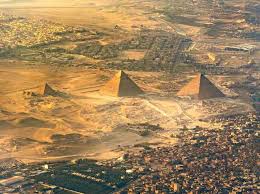Lost Nile Branch Key To Pyramid Construction:

A study discovered an ancient Nile river branch that helped transport workers and materials to Egypt’s pyramids, now buried under modern landscapes.
- Researchers employed technologies including satellite imagery, high-resolution digital elevation data, and historical maps to trace the path of the now-vanished Ahramat Branch of Nile River.
Key Highlights of the Study:
- The revelation of the Ahramat Branch, a previously unknown Nile channel from Lisht (village) to Giza (city), illuminates its crucial role in transporting workers and materials for pyramid construction, offering insight into their geographic and logistical considerations.
- The study shows that natural events such as climate change, tectonic shifts, and human activities, along with environmental factors like desertification and changes in rainfall, have altered the Nile’s landscape, and branches over time, impacting the region’s ecology and water systems.t.
- The pyramids of Egypt are massive, ancient stone structures built as tombs for pharaohs (ancient Egyptian rulers) and important figures during the Old Kingdom (roughly 2700–2200 BCE) and Middle Kingdom periods (2050–1650 BCE).




